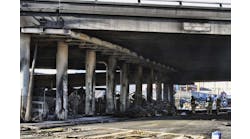A July 29 Obama administration proposal to increase fuel efficiency standards for cars and light trucks to an average 54.5 miles per gallon (mpg) between 2017 and 2025 would result in the loss of more than $65 billion in federal funding for state and local highway, bridge and transit improvements, an analysis by the American Road & Transportation Builders Association (ARTBA) shows.
The impact on the nation's transportation improvement program, ARTBA President Pete Ruane says, would be like eliminating all federal highway funding for nearly two years.
"Like everyone else, we are supportive of efforts to reduce carbon emissions and improve fuel economy. However, from a public policy perspective, this is a classic case of the left hand not knowing what the right hand is doing," Ruane said. "It's irresponsible to advance such proposals without acknowledging and attempting to mitigate the adverse effect they would have on other areas of federal responsibility like making infrastructure improvements that improve safety, reduce traffic congestion, create jobs and help grow the economy."
President Obama reached an agreement with 12 major automakers to pursue the next phase in the administration’s national vehicle program, increasing fuel economy to 54.5 mpg for cars and light-duty trucks by model year 2025. Together with a previous Obama action to raise fuel efficiency, American families will save $1.7 trillion at the pump, and by 2025 result in an average fuel savings of over $8,000 per vehicle.
Additionally, these programs will dramatically cut oil consumption, saving a total of 12 billion barrels of oil, and by 2025 reduce oil consumption by more than 4 million barrels of oil a day, more than America currently imports from the Persian Gulf, Venezuela, and Russia combined.
The standards also curb carbon pollution, cutting more than 6 billion metric tons of greenhouse gas over the life of the program, equivalent to an entire year’s worth of carbon dioxide emissions from the U.S.
Per-gallon federal gasoline and diesel taxes collected at the pump are deposited into the federal Highway Trust Fund (HTF). By law, these excises are the primary revenue source for financing road, bridge and transit projects. The less motor fuel used by drivers, the less revenue generated for improvements financed through the HTF.
The analysis, conducted by Dr. William Buechner, a Harvard-trained economist and ARTBA vice president of economics & research, assumes the increase in fuel efficiency standards between now and 2016 will occur as required (the Obama administration in 2010 put in place an increase from an average 28.3 to 34.1 mpg by 2016). It also assumes the mpg requirement will be phased in at 5% per year from 2017 through 2025 as proposed. The baseline for calculating revenue losses is the U.S. Treasury's February 2009 projections of HTF revenues. As new cars and light trucks are purchased in the future and old ones retired, average fuel economy will improve, reducing the 2009 forecast of gasoline sales and HTF revenues.
The HTF is already taking a revenue hit with the standards put in place in 2010, Buechner says. From fiscal years 2010-16, he estimates that action will cost the HTF about $9 billion. Thus, if the new standards are enacted, the total loss of revenue for transportation improvements through 2025 is projected at $75 billion.
Given the nation's overwhelming infrastructure needs, Ruane said the nearly two-year-overdue federal highway and transit program reauthorization bill provides a ripe opportunity for Congress and the president to identify all possible options to generate the revenues necessary to maintain and improve the system.


